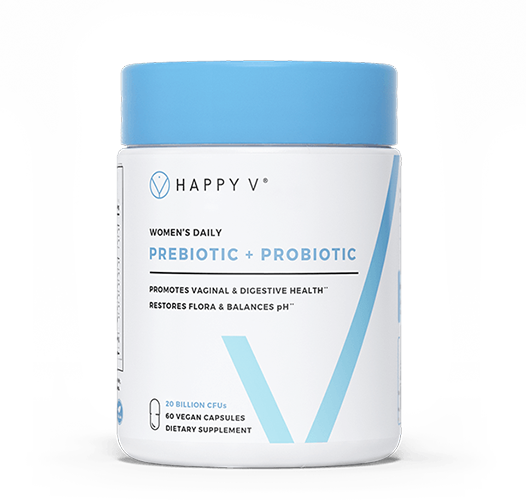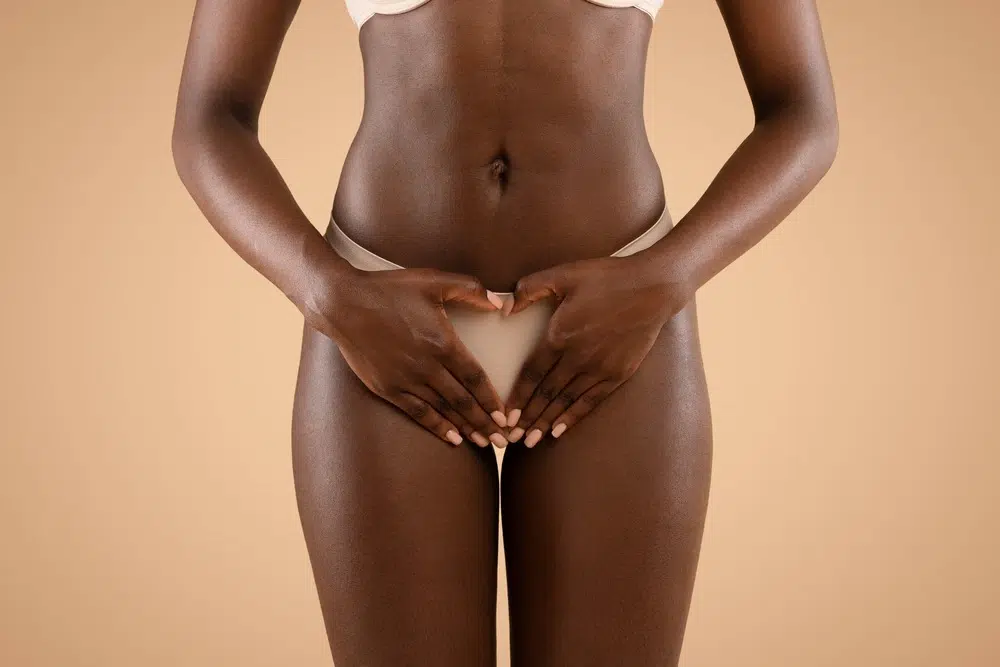- Vaginal yeast infections, also called vaginal candidiasis, are a fungal infection of the vagina characterized by itching, intense discomfort, unusual vaginal discharge, and irritation around the vagina and vulva.
- UTIs are defined as a bacterial infection in any region of the urinary tract, such as the urethra, bladder, ureters, or kidneys. UTIs mostly occur in the lower region of the urinary tract in the bladder or urethra.
- If you’re experiencing any genital discomfort, it’s best to consult a healthcare provider to get a proper diagnosis before starting any medications or therapy yourself.
Whenever people experience discomfort in their genitals, the first thing that comes to mind is an infection. Women in particular are extremely susceptible to vaginal infections, including urinary tract infections (UTI) and yeast infections. In fact, an estimated 25–40% of women between the ages of 20–40 in the United States have had a UTI at least once in their life. (1) Similarly, the prevalence of yeast infections is also very high, with over 1.4 million outpatient visits annually in the United States for vaginal candidiasis, the most common type of yeast infection. (2)
If you feel discomfort in your genitals, it’s a safe bet that you might need treatment for a yeast infection or UTI. But treating your symptoms yourself with over-the-counter medications or home remedies, like taking apple cider vinegar baths, can be dangerous. That’s because home remedies don’t always completely cure genital infections. Vaginal infections can worsen if they’re not treated properly, and they exhibit similar symptoms to some serious conditions and increase the risk of contracting sexually transmitted infections.
Knowing the difference between yeast infections and UTIs can help you identify your infection so you can get effective treatment and avoid further complications. In this article, we’ll go over the symptoms and causes of yeast infections vs. UTIs as well as when to seek medical treatment for both common conditions.

What Is a Yeast Infection?
Vaginal yeast infections, also called vaginal candidiasis, are a fungal infection of the vagina characterized by itching, intense discomfort, unusual vaginal discharge, and irritation around the vagina and vulva. (3) They’re triggered by the growth of the fungus Candida in the vagina. About 20% of women naturally have Candida in the vagina without any symptoms, but for others, the presence of Candida can cause a yeast infection. (4)
Yeast infections are the second most common type of vaginal infection, affecting millions of people every year.
What is a Urinary Tract Infection (UTI)?
UTIs are defined as a bacterial infection in any region of the urinary tract, such as the urethra, bladder, ureters, or kidneys. UTIs mostly occur in the lower region of the urinary tract in the bladder or urethra.
Seven million women develop UTIs every year in the U.S., with 26% to 44% of those experiencing a recurrence within 6 months. (5)
Symptoms of Vaginal Yeast Infections
The following signs and symptoms are common with yeast infections: (6)
- Pain during sex
- Pain during urination
- Swelling in the affected genital area (vagina and vulva)
- Itchiness in the affected area
- Unusual odorless white discharge
- Sores – typically painful and raw
- Bumps – may feel firm and are often less painful.
Symptoms of UTIs
The following are signs and symptoms are typical of UTIs:
- Frequent urination
- Strong smell of urine
- Painful urination
- Change in color of urine (from pale yellow to dark yellow or reddish-pink)
- Change in appearance of urine (from clear to cloudy)
- Abdominal pain, especially in women
- Foul-smelling urine
- Fever, chills, nausea, and vomiting in case of severe infections
- Strong urge to urinate while sleeping

Causes of Yeast Infections
Any of the following conditions or scenarios can cause a vaginal yeast infection: (7)
- Hormonal changes: Changes in the levels of your hormones, including during pregnancy, menstruation, or while on hormonal birth control, can increase your risk of yeast infections. Pregnant women are particularly likely to develop yeast infections because changing hormone levels affect the vagina’s pH.
- Antibiotic use: Antibiotics are an important way to treat some infections. Unfortunately, antibiotics can’t differentiate between good bacteria and bad bacteria, so sometimes, they kill good bacteria which protect the body from infections. Long-term antibiotic use can cause real changes in the microbiome, so always pair it with a good probiotic for vaginal health.
- Use of douches and vaginal chemicals: The use of these chemical products for your vagina can change the balance of bacteria in the vaginal environment, making your genital tract more susceptible to infections.
- Diabetes: There is a direct relationship between sugar and yeast infections. Uncontrolled blood sugar levels due to diabetes can cause an imbalance of sugar levels in the membranes of your vagina, making the environment suitable for yeast to grow.
Causes of UTIs
UTIs typically occur when bacteria enter the urinary tract and begin to multiply, causing an infection. (8) The most common types of bacteria which can cause UTIs are:
- Escherichia coli (75%)
- Proteus mirabilis (2%)
- Pseudomonas aeruginosa (1%)
- Streptococcus agalactiae (3%)faecalis
- Staphylococcus aureus (1%)
Several common scenarios can increase your risk of infection. These include:
- Wearing constrictive clothing, such as tight underwear or wet swimsuits
- Using certain feminine hygiene products, like vaginal cleansers and intimate wipes
- Using a diaphragm for birth control instead of other methods such as birth control pills or Nexplanon
How Do Doctors Diagnose Yeast Infections?
In most cases, yeast infections should be diagnosed by a medical professional. Yeast infections are usually diagnosed by taking a swab at the affected area, which is then tested in a laboratory for the presence of Candida fungus. (9)
How Do Doctors Diagnose UTIs?
A UTI is most likely to be diagnosed by a medical professional through a urine sample. The sample is then tested in the laboratory for the presence of certain bacteria.
Yeast Infection Treatment
According to the Mayo Clinic, the treatment of yeast infections depends upon the intensity and severity of the infection and its symptoms.
If you have a moderate to mild yeast infection, then the following treatment options are common:
- Short-term therapy: This therapy involves taking oral antibiotics for three to seven days. The most common anti-fungal medication given for this purpose are miconazole and terconazole. They are available as creams, ointments, suppositories, and tablets.
- Single-dose therapy: Sometimes, doctors may prescribe a single oral dose of fluconazole. This type of therapy is contraindicated in pregnancy.
- Drink at least 8-10 glasses of water per day to help flush out yeast infections
If you have a severe yeast infection, then the following treatment types are more common:
- Long-term therapy: This treatment option requires you to take anti-fungal medications daily for one to two weeks. The therapy is repeated every six months to prevent yeast infections from recurring.
- Multi-dose therapy: This therapy requires you to take multiple doses of anti-fungal medications orally. It is contraindicated in pregnancy.
If you’d like to try to treat your yeast infection naturally, try Happy V’s probiotic for vaginal health. It was developed by doctors to naturally restore your vaginal pH and support good bacteria.

How To Care For UTIs
Antibiotics are the best way to treat UTIs. (10) The length of treatment, however, depends upon the severity of the infection.
If you have a mild UTI, then you can consider one of the following antibiotics:
- Ceftriaxone
- Trimethoprim
- Fosfomycin
- Cephalexin
- Nitrofurantoin

If you have frequent UTIs, then your doctor might recommend one of the following:
- A low dose of antibiotics taken continuously for six months
- A single antibiotic dose after sex if UTI is aggravated by sexual activity
- Vaginal therapy with estrogen is common for post-menopausal women
As an alternative to antibiotics, you can also try products that contain D-mannose and cranberry.
- Happy V D-Mannose + Cranberry to help eliminate the symptoms of UTIs by working to flush the bad bacteria from the urinary tract.
- To prevent UTIs from occurring, try Happy V’s D-Mannose + Cranberry Stick Packs. Think of this formula as a super immune booster.

If untreated, UTIs can result in kidney infections, so in the case of severe UTIs, therapy with intravenous antibiotics is required in a hospital.
Call Your Doctor If You Think You Have a Yeast Infection or UTI
It’s important to know the symptoms, causes, diagnosis, and treatment of yeast infections vs UTIs. However, if you’re experiencing any genital discomfort, it’s best to consult a healthcare provider to get a proper diagnosis before starting any medications or therapy yourself.

D-Mannose + Cranberry
Our Happy V® D-Mannose + Cranberry was created for anyone who is experiencing symptoms related to Urinary Tract Infections. Eliminate the pain, burning sensation, constant need to urinate and vaginal irritation.
Learn moreWhen you’re ready to take control of your genital health, check out Happy V for specially formulated products, like our probiotic for vaginal health, to prevent pesky UTIs from occurring and balance good bacteria in your vagina.
- https://emedicine.medscape.com/article/233101-overview#a5
- https://www.cdc.gov/fungal/diseases/candidiasis/genital/index.html
- https://www.mayoclinic.org/diseases-conditions/yeast-infection/symptoms-causes/syc-20378999
- https://www.cdc.gov/fungal/diseases/candidiasis/genital/index.html
- https://liveutifree.com/
- https://sci-hub.tw/10.1136/bmj.4.5843.761
- https://www.webmd.com/women/guide/understanding-vaginal-yeast-infection-basics#1
- http://citeseerx.ist.psu.edu/viewdoc/download?doi=10.1.1.407.6144&rep=rep1&type=pdf
- https://www.healthline.com/health/yeast-infection-vs-urinary-tract-infection#diagnosis
- https://www.ncbi.nlm.nih.gov/pmc/articles/PMC4457377/
Check out Our Prebiotic + Probiotic to cover all your women wellness needs!
- A-
- A+
Check out Our Prebiotic + Probiotic to cover all your women wellness needs!





